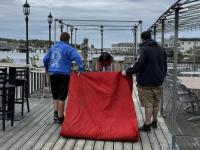Common Core Standards: Clearly defined skills and learning
There will always be a need for well educated children in all learning institutions. But what exactly should students in each grade be proficient at by the end of a school year? The Common Core Standards were developed to answer that question. Maine adopted the Standards in English/language arts and mathematics two years ago.
Adoption of the Standards for Next Generation Science is pending with most of the hold up related to the subjects of evolution and climate change, according to Assistant Superintendent Shawn Carlson.
Standards define what skills and knowledge students are supposed to have at each grade level, and make sure that learning is taking place. Common Core has been adopted by 45 states providing consistent expectations for students and teachers. Common Core doesn't dictate how learning will happen, teachers can be as inventive as they wish.
“Most teachers like the Standards,” Carlson said, “because they know what is expected.”
Students are not the only ones learning; through the use of the Atlas Curriculum Mapping software, teachers within AOS 98 (Boothbay-Boothbay Harbor, Edgecomb, Southport and Georgetown), can share lessons, strategies and learning materials used with each other for ideas, or to initiate dialogue. Atlas also makes communication with students and parents easier. It provides all concerned with a kind of “road map” chronicling the primary and secondary education experiences.
At the December meeting of the Boothbay-Boothbay Harbor Community School District School Committee, Carlson's presentation illustrated how Maine is aligning Atlas with the Standards set for grades K-12.
Carlson said the Standards were built on research of how people learn. Within the Standards are opportunities to address any issues a student may have achieving the necessary skills.
In 2015, graduation will depend on the mastery of skills within each content area.
Currently there are Standards for English/language arts, mathematics and science (Next Generation Science). Carlson presented the six shifts in each subject that made for the alignment, focusing on what he considered to be the most important.
English/language arts: magazine articles can now be added as a source of reading materials; vocabulary will be built and retained through recurrent use and challenging text. Student reading must be split 50-50 between fiction and non-fiction in K-12 to develop necessary skills.
In mathematics, the focus will be narrowed down to the concepts required by the Standards at each grade level and practice repeated to ensure memorization. Students need to learn multiple ways to problem solve.
“The Standards' expectations are rigorous, especially in math,” Carlson said. “They have real targets.
Next Generation Science Standard shifts dictate new subjects will be introduced each year with subsequent year's studies building on previous learning; technology and engineering should be integrated into science areas. In essence, Next Generation Science integrates the STEM subjects of science, technology, engineering and mathematics.
“The science inquiries of scientists and engineers are not much different than problem solving,” Carlson said. “Building on engineering principles with Next Gen is a really cool shift.”
Carlson said the AOS will have two years to align all shift changes. He added that art is the next subject with Standards in the next few years.
The school committee will meet for its first 2013-2014 budget meeting on Wednesday, Jan. 8 at 5:15 p.m.
Event Date
Address
United States





















